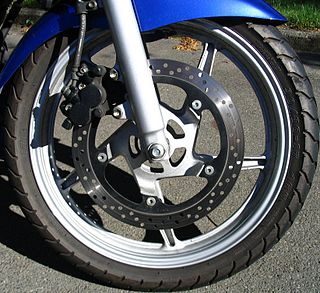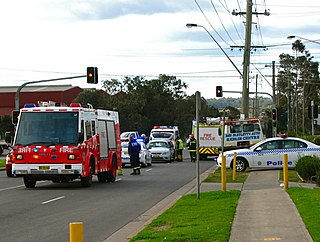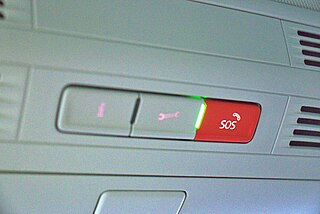This article needs additional citations for verification .(July 2015) |
Emergency response systems are means for emergency response teams to locate and move resources to emergency sites.
This article needs additional citations for verification .(July 2015) |
Emergency response systems are means for emergency response teams to locate and move resources to emergency sites.
ERA-GLONASS is the modern Russian system of emergency response, similar to the European standard eCall/E112. The system is designed for use with the Russian global satellite navigation system GLONASS on behalf of the Government of the Russian Federation. [1]
Since 2018, Russian federation is a member of the UNECE Regulation 144 [2] related to accident emergency call components (AECC), accident emergency call devices (AECD) and accident emergency call systems (AECS). [3]
Since 2001, authorities have implemented project E911, which tries to automatically associate a location with the origin of calls to 9-1-1 emergency services. In 2006, the Next Generation 9-1-1 (NG 9-1-1) initiative was introduced. The purpose of the initiative is to afford any emergency caller the opportunity to use any communication means for connection to the emergency services operator, which in turn can receive location data from fixed and mobile phones, as well as automatic sensor-activated devices in case of accidents. In 2010, the system was tested and has become widely implemented. The planning and progress is underway fr a more digital technology under the National 911 Program, under supervision of the National Highway Traffic Safety Administration Office of Emergency Medical Services. [4]
Several states are deploying several response systems for various issues. Georgia has Peer2Peer Warm Lines that offer support from trained specialists to people facing challenges who may not require severe emergency response. Oklahoma shares first responders with tablets equipped with crisis de-escalation tools. Florida is offering a full care service for mental health crisis intervention [5] that includes treatment, from home, drug addiction services and child care.
In 2001, countries within the European Union implemented the eCall program. eCall is an initiative to bring rapid assistance to motorists involved in collisions and is not designed to allow vehicle tracking outside of emergencies. Some European countries equip trucks with similar devices, containing navigational and communication components. In 2005, Germany began installing eCall devices on trucks with a carrying capacity exceeding 12 tonnes. Trucks in Sweden greater than 3.5 tonnes install the automatic connection devices. The European Commission proposals for legislative acts predicted eCall would be seamlessly functioning in most European vehicles by end of 2015. The deadlines for implementation will most likely be delayed to the end of 2017 or early 2018, [6] as the adoption procedure of these legislative acts by the European Parliament and the Council is not complete.
An eCall equipped car transmits a 1-1-2 emergency call through the Private GSM frequency, to the closest radio tower, to ensure the signal is sent to the appropriate PSAP, as fast as possible. If none of the passengers involved in the collision are able to speak, a minimum data set is sent, including the coordinates of the vehicle.
Since 2018, European Union is a member of the UNECE regulation 144 related to accident emergency call components (AECC), accident emergency call devices (AECD) and accident emergency call systems (AECS). [7]
Kazakhstan has developed an analog system ERA GLONASS [8] called "EVAK" – an emergency call in case of emergencies and disasters. It operates using signals from navigation satellite systems GLONASS and GPS. It is expected in 2016 to equip the system board passenger vehicles weighing over 2.5 tonnes, buses, trucks and special vehicles for the transport of dangerous goods, and in 2017 – all other vehicles.
Since 2018, Kazakhstan is a member of the UNECE regulation 144 related to accident emergency call components (AECC), accident emergency call devices (AECD) and accident emergency call systems (AECS). [9]

The United Nations Economic Commission for Europe is one of the five regional commissions under the jurisdiction of the United Nations Economic and Social Council. It was established in order to promote economic cooperation and integration among its member states.

A brake is a mechanical device that inhibits motion by absorbing energy from a moving system. It is used for slowing or stopping a moving vehicle, wheel, axle, or to prevent its motion, most often accomplished by means of friction.

Emergency services and rescue services are organizations that ensure public safety, security, and health by addressing and resolving different emergencies. Some of these agencies exist solely for addressing certain types of emergencies, while others deal with ad hoc emergencies as part of their normal responsibilities. Many of these agencies engage in community awareness and prevention programs to help the public avoid, detect, and report emergencies effectively. Emergency services are often considered first responders, and typically have dedicated emergency vehicles.

A bumper is a structure attached to or integrated with the front and rear ends of a motor vehicle, to absorb impact in a minor collision, ideally minimizing repair costs. Stiff metal bumpers appeared on automobiles as early as 1904 that had a mainly ornamental function. Numerous developments, improvements in materials and technologies, as well as greater focus on functionality for protecting vehicle components and improving safety have changed bumpers over the years. Bumpers ideally minimize height mismatches between vehicles and protect pedestrians from injury. Regulatory measures have been enacted to reduce vehicle repair costs and, more recently, impact on pedestrians.

Dangerous goods (DG), are substances that are a risk to health, safety, property or the environment during transport. Certain dangerous goods that pose risks even when not being transported are known as hazardous materials. An example for dangerous goods is hazardous waste which is waste that has substantial or potential threats to public health or the environment.

eCall is an initiative by the European Union, intended to bring rapid assistance to motorists involved in a collision anywhere within the European Union. The aim is for all new cars to incorporate a system that automatically contacts the emergency services in the event of a serious accident, sending location and sensor information. eCall was made mandatory in all new cars approved for manufacture within the European Union as of April 2018.

A daytime running lamp is an automotive lighting and bicycle lighting device on the front of a road going motor vehicle or bicycle. It is automatically switched on when the vehicle's handbrake has been pulled down, when the vehicle is in gear, or when the engine is started, emitting white, yellow, or amber light. Their intended use is not to help the driver see the road or their surroundings, but to help other road users identify an active vehicle.

A motor vehicle has lighting and signaling devices mounted to or integrated into its front, rear, sides, and, in some cases, top. Various devices have the dual function of illuminating the road ahead for the driver, and making the vehicle visible to others, with indications to them of turning, slowing or stopping, etc., with lights also indicating the size of some large vehicles.
Federal Motor Vehicle Safety Standard 108 regulates all automotive lighting, signalling and reflective devices in the United States. Like all other Federal Motor Vehicle Safety Standards, FMVSS 108 is administered by the United States Department of Transportation's National Highway Traffic Safety Administration.

The World Forum for Harmonization of Vehicle Regulations is a working party (WP.29) of the Inland Transport Committee (ITC) of the United Nations Economic Commission for Europe (UNECE). Its responsibility is to manage the multilateral Agreements signed in 1958, 1997 and 1998 concerning the technical prescriptions for the construction, approval of wheeled vehicles as well as their Periodic Technical Inspection and, to operate within the framework of these three Agreements to develop and amend UN Regulations, UN Global Technical Regulations and UN Rules, kind of vehicle regulation.

Marion County’s Emergency Medical Services Alliance, Inc. (EMSA) was a non-profit governmental Emergency Medical Services (EMS) agency created by a partnership between The Marion County, Florida Board of County Commissioners, The City of Ocala, Ocala Regional Medical Center/West Marion Community Hospital and Munroe Regional Medical Center. EMSA was responsible for providing leadership, field supervision and medical direction for 911 based emergency medical services responses, patient contacts, and ambulance transportation within the 1,653-square-mile (4,280 km2) service area in North Central Florida from 2003 to 2008.
An event data recorder (EDR), more specifically motor vehicle event data recorder (MVEDR), similar to an accident data recorder, (ADR) sometimes referred to informally as an automotive black box, is a device installed in some automobiles to record information related to traffic collisions. In the USA EDRs must meet federal standards, as described within the U.S. Code of Federal Regulations.
Brake assist or emergency brake assist (EBA) is a term for an automobile braking technology that increases braking pressure in an emergency. The first application was developed jointly by Daimler-Benz and TRW/LucasVarity. Research conducted in 1992 at the Mercedes-Benz driving simulator in Berlin revealed that more than 90% of drivers fail to brake with enough force when faced with an emergency.
Ford Sync is a factory-installed, integrated in-vehicle communications and entertainment system that allows users to make hands-free telephone calls, control music and perform other functions with the use of voice commands. The system consists of applications and user interfaces developed by Ford and other third-party developers. The first two generations run on the Windows Embedded Automotive operating system designed by Microsoft, while the third and fourth generations run on the QNX operating system from BlackBerry Limited. Future versions will run on the Android operating system from Google.
Vehicle regulations are requirements that automobiles must satisfy in order to be approved for sale or use in a particular country or region. They are usually mandated by legislation, and administered by a government body. The regulations concern aspects such as lighting, controls, crashworthiness, environment protection and theft protection, and might include safety belts or automated features.
Government regulation in the automotive industry directly affects the way cars look, how their components are designed, the safety features that are included, and the overall performance of any given vehicle. As a result, these regulations also have a significant effect on the automotive business by generally increasing production costs while also placing limitations on how cars are sold and marketed. Automotive regulations are designed to benefit the consumer and protect the environment, and automakers can face stiff fines and other penalties if they are not followed.
Ambulance Services in Hong Kong are provided by the Hong Kong Fire Services, in co-operation with two other voluntary organisations, the Auxiliary Medical Service and the Hong Kong St. John Ambulance.
Next Generation 911 refers to an initiative aimed at updating the 911 service infrastructure in the United States and Canada to improve public emergency communications services in a growing wireless mobile society. In addition to calling 911 from a phone, it intends to enable the public to transmit text, images, video and data to the 911 center. The initiative also envisions additional types of emergency communications and data transfer. This NG911 infrastructure is intended to replace the current services over time. The National Emergency Number Association (NENA) first identified the need for NG911 in 2000, and started development actions in 2003, and is nearing full definition and standards for NG911. Since 2006, the US Department of Transportation (DOT) in the United States and the Canadian Radio-television and Telecommunications Commission (CRTC) in Canada have been leading their respective initiatives, which include research and development projects aimed at advancing NG911. On January 24, 2013, the CRTC announced the first step toward a Canadian implementation of NG911 and, in March 2016, began a consultation with the public to discuss what services should be offered, who will play a role in offering these services and how these services should be paid for. Several US states have implemented versions of NG911, as of October 2013.
Motor vehicle type approval is the method by which motor vehicles, vehicle trailers and systems, components and separate technical units intended for such vehicles achieve type approval in the European Union (EU) or in other UN-ECE member states. There is no EU approval body: authorized approval bodies of member states are responsible for type approval, which will be accepted in all member states.

The World Forum for Harmonization of Vehicle Regulations define AEBS. UN ECE regulation 131 requires a system which can automatically detect a potential forward collision and activate the vehicle braking system to decelerate a vehicle with the purpose of avoiding or mitigating a collision. UN ECE regulation 152 says deceleration has to be at least 5 metres per second squared.
Emergency Assist is a driver assistance system that monitors driver behavior by observing delays between the use of the accelerator and the brake; once a preset threshold of time has been exceeded the system will take control of the vehicle in order to bring it to a safe stop.